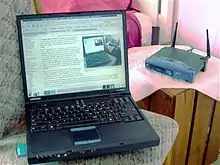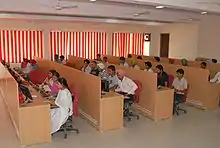Outline of computing
The following outline is provided as an overview of and topical guide to computing:
Computing – activity of using and improving computer hardware and computer software.
Branches of computing
- Computer science (see also Outline of computer science)
- Information technology – refers to the application (esp in businesses and other organisations) of computer science, that is, its use by mankind (see also Outline of information technology)
- Information systems – refers to the study of the application of IT to business processes
- Computer engineering (see also Outline of computer engineering)
- Software engineering (see also Outline of software engineering)
Computer science
Computers
See information processor for a high-level block diagram.
- Computer
- Computer hardware
- History of computing hardware
- Processor design
- Computer network
- Computer performance by orders of magnitude
Instruction-level taxonomies
After the commoditization of memory, attention turned to optimizing CPU performance at the instruction level. Various methods of speeding up the fetch-execute cycle include:
- designing instruction set architectures with simpler, faster instructions: RISC as opposed to CISC
- Superscalar instruction execution
- VLIW architectures, which make parallelism explicit
Software
- Software engineering
- Computer programming
- Computational
- Software patent
- Firmware
- System software
- Application Software
- Programming languages
- Speech recognition
- Speech synthesis
.jpg.webp)
Part of an early computer, EDSAC.
History of computing
Business computing
- Accounting software
- Computer-aided design
- Computer-aided manufacturing
- Computer-aided dispatch
- Customer relationship management
- Data warehouse
- Decision support system
- Electronic data processing
- Enterprise resource planning
- Geographic information system
- Hospital information system
- Human resource management system
- Management information system
- Material requirements planning
- Product Lifecycle Management
- Strategic enterprise management
- Supply chain management
- Utility Computing
Human factors
Computer network
Wired and wireless computer network

Computing technology based wireless networking (CbWN)
The main goal of CbWN is to optimize the system performance of the flexible wireless network.
- Source coding
- Codebook design for side information based transmission techniques such as Precoding
- Wyner-Ziv coding for cooperative wireless communications
- Security
- Dirty paper coding for cooperative multiple antenna or user precoding
- Intelligence
- Game theory for wireless networking
- Cognitive communications
- Flexible sectorization, Beamforming and SDMA
- Software
- Software defined radio (SDR)
- Programmable air-interface
- Downloadable algorithm: e.g., downloadable codebook for Precoding
Computer security
Data
Numeric data
- Integral data types – bit, byte, etc.
- Real data types:
- Floating point (Single precision, Double precision, etc.)
- Fixed point
- Rational number
- Decimal
- Binary-coded decimal (BCD)
- Excess-3 BCD (XS-3)
- Biquinary-coded decimal
- representation: Binary – Octal – Decimal – Hexadecimal (hex)
- Computer mathematics – Computer numbering formats
Character data
Other data topics
- Data compression
- Digital signal processing
- Image processing
- Data management
- Routing
- Data Protection Act
Classes of computers

Polish analog computer AKAT-1
There are several terms which describe classes, or categories, of computers:
- Analog computer
- Calculator
- Desktop computer
- Desktop replacement computer
- Digital computer
- Embedded computer
- Home computer
- Laptop
- Mainframe
- Minicomputer
- Microcomputer
- Personal computer
- Portable computer
- Personal digital assistant (aka PDA, or Handheld computer)
- Programmable logic controller or PLC
- Server
- Smartphone
- Supercomputer
- Tablet computer
- Video game console
- Workstation
Organizations

A computer Lab
Companies – current
Companies – historic
- Acorn, bought by Olivetti
- Amdahl Corporation, bought by Fujitsu
- Bendix Corporation
- Burroughs Corporation, merged with Sperry to become Unisys
- Compaq, bought by Hewlett-Packard
- Control Data
- Cray
- Data General
- Digital Equipment Corporation, bought by Compaq, later bought by Hewlett-Packard
- Digital Research – produced system software for early Intel microprocessor-based computers
- English Electric Company
- Ferranti
- General Electric, computer division bought by Honeywell, then Bull
- Honeywell, computer division bought by Bull
- ICL
- Leo
- Lisp Machines, Inc.
- Marconi
- Micro Instrumentation and Telemetry Systems produced the first widely sold microcomputer system (kit and assembled)
- Nixdorf Computer, bought by Siemens
- Norsk Data
- Olivetti
- Osborne
- Packard Bell
- PERQ
- Prime Computer
- Raytheon
- Royal McBee
- RCA
- Scientific Data Systems, sold to Xerox
- Siemens
- Sinclair Research, created the Sinclair ZX Spectrum, ZX80 and ZX81
- Southweat Technical products Corporation produced microcomputers systems (kit and assembled), peripherals, and software based on Motorola 6800 and 6809 microcomputer chips
- Sperry, which bought UNIVAC, and later merged with Burroughs to become Unisys
- Symbolics
- UNIVAC
- Varian Data Machines, a division of Varian Associates which was bought by Sperry
- Wang
Professional organizations
- Association for Computing Machinery (ACM)
- Association for Survey Computing (ASC)
- British Computer Society (BCS)
- Canadian Information Processing Society (CIPS)
- Computer Measurement Group (CMG)
- Institute of Electrical and Electronics Engineers (IEEE), in particular the IEEE Computer Society
- Institution of Electrical Engineers
- International Electrotechnical Commission (IEC)
Standards bodies
Open standards bodies
See also Open standard
- Apdex Alliance – Application Performance Index
- Application Response Measurement (ARM)
Computing publications
- Digital Bibliography & Library Project – as of July 2007, lists over 910,000 bibliographic entries on computer science and several thousand links to the home pages of computer scientists.
Persons influential in computing
Major figures associated with making personal computers popular.
External links
This article is issued from Wikipedia. The text is licensed under Creative Commons - Attribution - Sharealike. Additional terms may apply for the media files.
